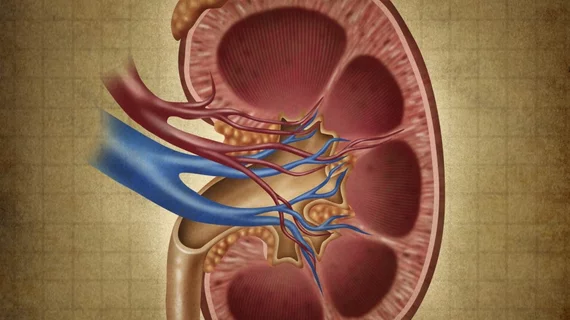Incidental renal lesions are commonly detected during lumbar spine MRI examinations. When that occurs, is follow-up imaging always necessary? The authors of a new study published in the American Journal of Roentgenology explored that very question.
“Routine unenhanced lumbar spine MRI represents a diagnostic challenge in the characterization of incidental renal lesions, because findings are often seen only on an unenhanced axial T2-weighted sequence,” wrote lead author Steve M. Nelson, from the department of radiology at San Antonio Medical Center, and colleagues. “Information regarding the imaging management of incidental renal lesions on unenhanced MRI is sparse, so follow-up imaging is often recommended. The purpose of this study was to evaluate whether the T2-weighted imaging features of renal lesions on lumbar spine MRI can reliably be used to distinguish complex renal lesions from simple cysts.”
The authors asked two independent body imaging specialists to retrospectively look at 149 renal lesions identified on lumbar spine MRI studies. Using T2-weighted imaging only, the specialists noted the presence or absence of a complex renal lesion.
Overall, of the 149 renal lesions, 115 were basic cysts and 34 were complex renal lesions. The specialists viewing lumbar spine MRI identified 72 as basic cysts and 77 as complex renal lesions. Reader sensitivity for detecting a complex renal lesion using lumbar spine MRI was 94 percent, specificity was 63 percent, positive predictive value was 43 percent and negative predictive value was 97 percent.
“The readers accurately identified nearly all complex renal lesions (94 percent) as well as all malignant and potentially malignant lesions,” the authors wrote. “In two instances, readers falsely classified a Bosniak II cyst (thin septations, thin calcifications) as a category I cyst, but this difference is likely of no clinical significance because both lesions are benign and do not require further imaging. These results indicate that, with current levels of diagnostic quality in clinical MRI, follow-up renal imaging may not be required for many incidentally discovered renal lesions.”
Nelson and colleagues noted these findings may help imaging providers cut down on overutilized tests and save a little money along the way. “More judicious patient selection for follow-up renal imaging recommendations on lumbar spine MRI may decrease the number of low-diagnostic-yielding follow-up examinations and lower associated healthcare costs,” they wrote.

